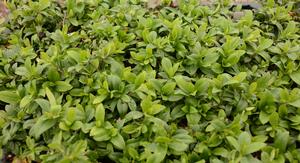Printed at http://www.newmoonnursery.com/index.cfm/

Woodland phlox makes an excellent groundcover, provides soil stabilization, and attracts birds, bees, and butterflies.
Phlox divaricata 'Blue Moon'
Woodland phlox
Native to North America (cultivar)
FIRST IMPRESSIONS: Phlox divaricata ‘Blue Moon’ is a handsome compact cultivar of our native woodland phlox. Plants have semi-evergreen lance shaped deep green leaves. In early spring, foliage is topped by loose clusters of large showy bluish lavender flowers. ‘Blue Moon’ is an excellent wildflower for shade gardens with moist well drained soil.
HABITAT & HARDINESS: The parent species Phlox divaricata occurs in eastern North America in Quebec and Ontario, south from Vermont to Florida and west to South Dakota and New Mexico. Plants are indigenous to rich deciduous woodlands, open moist to slightly dry woods, stream banks and open areas near woodland paths.
The cultivar ‘Blue Moon’ was introduced by the New England Wildflower Society. It was selected by Bill Cullina during his tenure as nursery manager at the Society’s Garden in the Woods in Framingham, Massachusetts. This variety is notable for its compact growth, fragrance and large deep bluish lavender flowers.
Plants are hardy from USDA Zones 4-8.
PLANT DESCRIPTION: Phlox divaricata ‘Blue Moon’ is a mounding rhizomatous perennial with multiple green or purplish erect or decumbent stems.
Leaves are lance shaped with smooth edges and blunt or pointed tips. Blades are 1-2” long and ½” wide. They are rounded at the base and have no petioles. The leaf surface is peppered with short fine hairs.
The leaves are opposite - arranged in widely spaced pairs along the stems. Each pair of blades is situated at a right angle to those above and below.
The fertile stems terminate in showy rounded flower cymes. The florets are very fragrant with 5 blue-violet overlapping petals. The lower part of the corolla is fused into a narrow tube.
Blooming occurs in early to mid-spring for about a month. Florets are followed by small inconspicuous oval capsules.
Plants grow 12” tall with an equal spread. They gradually form colonies from short rhizomes and spreading leafy stems that root at the nodes.
CULTURAL & MAINTENANCE NEEDS: Phlox divaricata ‘Blue Moon’ flourishes in bright shade with moist rich well drained acid soil. Plants tolerate clay loam, sand, part sun and dry shade.
Plants are fairly pest resistant but need good air circulation to prevent issues with powdery mildew.
LANDSCAPE USES: This is a good Groundcover for a Wildlife Garden or Shade Garden. Plants are also used as Butterfly Nectar Plants or as part of a Grouping or Mass Planting. In mild climates attractive rosettes provide Winter Interest. Phlox divaricata ‘Blue Moon’ has Showy Blooms and is appropriate for Cottage Gardens, Water-wise Landscapes, Low Maintenance Plantings and Perennial Borders.
COMPANION & UNDERSTUDY PLANTS: Try pairing Phlox divaricata ‘Blue Moon’ with Aquilegia canadensis, Carex albicans, Carex plantaginea, Heuchera americana 'Dales Strain', Dryopteris marginalis or Polystichum acrostichoides.
The parent species Phlox divaricata could be used as a substitute but flower color could vary into the pinkish range and plants would be taller.
TRIVIA: Phlox divaricata flowers are a valuable early season nectar source for swallowtail butterflies, day flying sphinx moths (like hummingbird moths and clearwing moths) and hummingbirds. Successful pollinators must have a long proboscis to navigate the long slender corolla tube. The leaves and stems are somewhat unpalatable to deer but are often nibbled by rabbits.
Height:
1 ftSpread:
1 ftUSDA Hardiness Zone:
4-8Bloom Color:
BluePhlox divaricata 'Blue Moon' Characteristics
Attracts Wildlife
- Pollinators
- Hummingbirds
- Butterflies
Attributes
- Rain Garden
- Fragrant
- Drought Tolerant
- Clay Soil
- Rock Garden
- Ground Cover
Exposure
- Full Shade to Partial Shade
Flowering Months
- May
- April
Foliage Color
- Green
Juglans nigra Tolerance (Black Walnut)
- Yes
Soil Moisture Preference
- Moist
